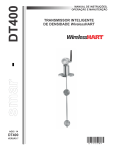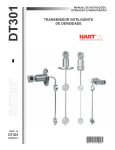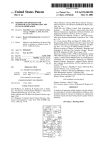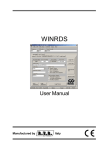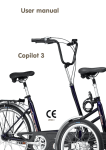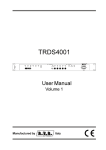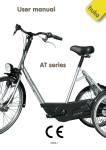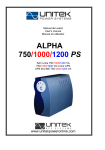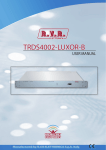Download Operating instructions
Transcript
BA 1731/1733 Operating instructions EN – Rev. 2 Page 1 / 7 Swing check valves Table of contents An incorrect use of the valves may cause strong consequences to the complete plant, such as: 1. 2. 3. 4. 5. 6. 7. 8. - escape of medium - standstill of a plant/machine - affects, decreases or increases of operation or work of a plant / machine Generalities Safety Corrosion protection, transport and storage Description / corresponding documents Installation Operation / putting into and out of operation Maintenance / Commissioning Malfunctions and their elimination 1. Generalities The following operating instructions are valid for KLAUS UNION swing check valves of the series 1731 and 1733, which are installed in pipelines and serve to let through the flow of liquids (gases and steams) in only one direction. KLAUS UNION valves are subjected to the rules according to the PED 97/23/EC and their harmonised standards / regulations, in their development, construction and testing. By a correct assembling, maintenance or repair we guarantee a trouble-free valve operation. The manufacturer carries no responsibility for efficiency and safety of the valves, whenever these operating instructions are not observed and followed accurately. The valves are marked, in accordance with DIN/EN 19 (ISO 5209) as follows: nominal diameter (DN), nominal pressure (PN), body material, heat-no or specimen-no, manufacturer brand, factory number, flow direction arrow, and if necessary, admissible working temperature and admissible operating pressure (bar). By attaching a CE marking to the valves, we concurrently declare compliance with PED 97/23/EC. ATTENTION The valves must not be activated beyond the limits and rules indicated in the different documents (such as operating instructions, purchase documents, type sheets). Operations beyond the indicated limits lead to overstrain which cannot be sustained by the valves. For any further inquiries or in case of damage, please contact KLAUS UNION GmbH & Co. KG, Bochum. In case of local inquiries or orders, especially for spare parts, please indicate the production or factory serial number, the type, the model version and possibly also the year of construction. The technical data (service data) referring to the valves can be found in their technical documentation (paragraph 4). In case of a return transport it has to be proceeded as explained in paragraph 3 <Transport>. 2. Safety These operating instructions contain essential information that has to be observed by assembling, operation and maintenance of the valves. For this reason they have to be read by the assembling staff, by the skilled staff and by the operator before the valves are assembled and put into operation and they should always be kept in the proximity of the valves. Not only the general safety instructions indicated in this main paragraph have to be observed, but also the other ones indicated in other paragraphs. 2.1 Indication of notes in the operating instructions The safety instructions contained in these operating instructions, which have to be observed in order to avoid injuries to persons, are indicated by the following general and particular picot-graphs: A non-observance of this warning can cause injuries to persons and defects of the machines, such as: - Injuries caused by escaped medium (cold/hot, toxic, under pressure) - Affect in activity or damage of the valves The descriptions and rules included in these operating instructions refer to standard types but are also valid for alternatives. These operating instructions do not take into consideration: Security signal acc. to DIN 4844 W 9 Beware of the electrical voltage! Any accident and incident which can arise by assembling, operation or maintenance of the valves. Any safety rule in relation with the place where the valve is installed. The operating company is responsible for the observation of the safety rules, - also by the assembling staff. ATTENTION It is essential that the valves are handled by skilled staff that must be aware of the interactions between the valves and the plants in which they are installed. Security signal acc. to DIN 4844 - W 8 . In order to avoid defects of valve efficiency and of its accessories the following warning mark has to be observed in safety instructions: ATTENTION The signs marked directly on the valves (such as nominal pressure) have absolutely to be considered and kept in a readable condition. BA 1731-1733 Swing check valves_Rev.2_EN.doc Issue 01/2010 KLAUS UNION GmbH & Co. KG Page 2 / 7 2.2 Dangers that can result if safety instructions are not observed. alities> of these operating instructions. The limits included in the technical documentation must not be exceeded. The non-observance of the safety instructions may cause risks to persons, the environment and the valves or plants. The nonobservance of the safety instructions may lead to the loss of any indemnity rights. 3. Corrosion protection, transport and storage In particular the non-observance of the safety notes can cause dangers such as: - break down of important functions of the valves / plants - failure of prescribed methods of maintenance and commissioning - danger to persons caused by electrical, mechanical and chemical impacts - environmental injuries caused by a leakage of dangerous materials 2.3 Working with safety consciousness The safety instructions included in these operating instructions, the national regulations for prevention of accidents, as well as the internal regulations referring to work, operation and safety have to be observed by the operator. 2.4 Safety instructions for the operator / user - Whenever some hot or cold valve parts (e.g. casing parts, lever or handwheel) may cause any danger, the operator must construct these parts in a way that they are protected from contacts. - The contact protection for moving parts (such as lever or weight) must not be taken away while the machine is working. - Leakages (f. ex. in shaft sealing) of dangerous conveyed materials (explosive, toxic, hot) have to be removed in a way that no danger to persons or environment can arise. Legal determinations must be respected. - Injuries by electrical energy have to be excluded (please find details to this point in the VDE and local power supply enterprise regulations). 2.5 Safety instructions for maintenance, inspection and assembly works. 3.1 Corrosion protection 3.1.1 Carbon steel valves Valves made out of unalloyed or low alloyed cast steel are painted with a hard sticking primer made of a 2-components colour based on epoxy resin paint. The minimum film thickness is 70 µm. The inner surfaces are free of paint and only coated with a temporary corrosion protection (e.g. oil). Machined flange facings are protected against outside influences with a strippable varnish. 3.1.2 Austenitic valves Valves made out of stainless austenitic cast steel will be delivered without coating. 3.2 Transport The valves are delivered with their connecting holes shut by cover caps. See that valves are not thrown or exposed to hard crushes. Valves will be supplied as ready for operation. ATTENTION During transport and intermediate storage valves have to be closed. Connecting holes have to be shut up by suitable means (cover caps, foils) in order to avoid any damage to the valve seats. Please see on this the “rise prescriptions“on page 7! Valve weights are indicated in the corresponding manufacturer documents (type sheets, paragraph 4.1 <Corresponding documents>, acknowledgement) After delivery, respectively before assembly the valves have to be inspected in order to exclude any transportation damage. 3.3 Storage It must be provided that all maintenance, inspection and assembly works are executed by skilled staff, who must have previously studied these operating instructions. The storage / intermediate storage of the valves has to be effected in a way that it can work perfectly even after a longer storage period. For this purpose it is necessary: Basically when any kind of work on valves is executed, they have to be cooled down and free of pressure. And the vaporisation temperature of the medium must be lower than the temperature of all parts it gets in contact with. - to keep the valve closed (in order to protect the seat facings) - to take measures against soiling (dust, sand, mortar, respectively building materials), frost and corrosion (e.g. using plastic foils) Valves which get in contact with health injuring media have to be decontaminated. Immediately after the work is done, all safety and protection devices have to be put into position or operation again. Before putting the valve into operation again, the points referring to paragraph 6 <Putting into operation> have to be observed. 2.6 Independent conversion and spare parts manufacture Reconstructions or modifications of the valves are only acceptable under agreement with the manufacturer. The use of original spare parts and by the manufacturer authorised accessories promotes safety. Any violations cause the liability for the consequences arising to be cancelled. When storing valves with soft gaskets (seat and / or stem seal of elastomer) the storage regulations for elastomer (DIN 7716) have to be observed: - the store must be dry, free of dust and moderately ventilated. Store temperature should not go over +25 °C - stocks on hand have to be used up in order to avoid long storage periods - as already mentioned above, the valves have to be in ”closed“position during the storage. However the soft closure elements should be shut with little power, in order to avoid a rush ageing of the elastomer 2.7 Inadmissible operation modes A safe operation is only guaranteed if the valves are used according to the determinations included in paragraph 1 <Gener- BA 1731-1733 Swing check valves_Rev.2_EN.doc Issue 09/2011 KLAUS UNION GmbH & Co. KG 4. Description / corresponding documents The following pictures represent some examples for the principle valve construction. Pictures and information referring to particular construction series can be found in the corresponding type sheets. 4.1 Overview: corresponding documents 4.1.1 Swing check valves with interior shaft Connecting flange in accordance with EN 1092-1 (DIN 2501) Sealing edge in accordance with EN 1092-1 (DIN 2526) Constructional length in accordance with EN 558 (DIN 3202) Type PN Material Type sheet no. Constructional length EN 558-1 series 48 (DIN 3202-F6) 1731 10-16 1.0619 1731.100-200.040 1731 10-16 1.5419 1731.100-200.041 1731 10-16 1.7219 1731.100-200.044 1731 10-16 1.7357 1731.100-200.042 1731 10-16 1.7363 1731.100-200.043 1731 1731 1731 1731 10-16 10-16 10-16 10-16 1.4308 1.4408 1.4552 1.4581 1731.100-200.202 1731.100-200.205 1731.100-200.203 1731.100-200.206 Constructional length EN 558-1 series 1 (DIN 3202-F1) 1731 10-40 1.0619 1731.100-400.040 1731 10-40 1.5419 1731.100-400.041 1731 10-40 1.7219 1731.100-400.044 1731 10-40 1.7357 1731.100-400.042 1731 10-40 1.7363 1731.100-400.043 1731 1731 1731 1731 10-40 10-40 10-40 10-40 1.4308 1.4408 1.4552 1.4581 1731.100-400.202 1731.100-400.205 1731.100-400.203 1731.100-400.206 Page 3 / 7 4.1.2 Swing check valve with pass-through shaft, lever and weight Connecting flange in accordance with EN 1092-1 (DIN 2501) Sealing edge in accordance with EN 1092-1 (DIN2526) Constructional length in accordance with EN 558 (DIN 3202) Type PN Material Type sheet no. Constructional length EN 558-1 series 48 (DIN 3202-F6) 1733 10-16 1.0619 1733.100-200.040 1733 10-16 1.5419 1733.100-200.041 1733 10-16 1.7219 1733.100-200.044 1733 10-16 1.7357 1733.100-200.042 1733 10-16 1.7363 1733.100-200.043 1733 1733 1733 1733 10-16 10-16 10-16 10-16 1.4308 1.4408 1.4552 1.4581 1733.100-200.202 1733.100-200.205 1733.100-200.203 1733.100-200.206 Constructional length EN 558-1 series 1 (DIN 3202-F1) 1733 10-40 1.0619 1733.100-400.040 1733 10-40 1.5419 1733.100-400.041 1733 10-40 1.7219 1733.100-400.044 1733 10-40 1.7357 1733.100-400.042 1733 10-40 1.7363 1733.100-400.043 1733 1733 1733 1733 10-40 10-40 10-40 10-40 1.4308 1.4408 1.4552 1.4581 1733.100-400.202 1733.100-400.205 1733.100-400.203 1733.100-400.206 Constructional length EN 558-1 series 2 (DIN 3202-F2) 1733 63-160 1.0619 1733.500-700.040 1733 63-160 1.5419 1733.500-400.041 1733 63-160 1.7219 1733.500-400.044 1733 63-160 1.7357 1733.500-400.042 1733 63-160 1.7363 1733.500-400.043 1733 1733 1733 1733 63-160 63-160 63-160 63-160 1.4308 1.4408 1.4552 1.4581 1733.500-700.202 1733.500-700.205 1733.500-700.203 1733.500-700.206 Constructional length EN 558-1 series 2 (DIN 3202-F2) 1731 63-160 1.0619 1731.500-700.040 1731 63-160 1.5419 1731.500-400.041 1731 63-160 1.7219 1731.500-400.044 1731 63-160 1.7357 1731.500-400.042 1731 63-160 1.7363 1731.500-400.043 1731 1731 1731 1731 63-160 63-160 63-160 63-160 1.4308 1.4408 1.4552 1.4581 1731.500-700.202 1731.500-700.205 1731.500-700.203 1731.500-700.206 BA 1731-1733 Swing check valves_Rev.2_EN.doc Issue 09/2011 KLAUS UNION GmbH & Co. KG 4.2 Parts index Pos. Denomination 1 Body 2 Cover 3 Lever 4 Disc/Flap 5 Shaft 7 Lever 8 Weight 10 Stuffing box with bolt and nut 11 Packing 12 Seal 13 Locking ring 18 Bolt 19 Nut 22 Screw plug 23 Seal ring 4.3 Function mode Swing check valves consist of the pressurised parts body (1) and cover (2), as well as the functional unit. Body (1) and cover (2) are connected by the stud bolts (18) and nuts (19) and are sealed up outside by the gasket (12). The block device consists essentially of the disc/flap (4), the lever (3) and the shaft (5). The shaft (5) is sealed up outside using seal rings (23) and screw plugs (22) on both sides. In the case of the design with lever (7) and weight (8), the shaft (5) passes through one-sided. Here, the shaft is sealed up using packing rings (11) and the stuffing box (10). The tight surfaces of the body seat (1) and the valves (4) are made of stainless steel. 4.4 Application limits ATTENTION Depending on the materials the pressure temperature graduations (rating tables) of the respective materials are to be taken in consideration. Moreover, application is limited depending on the choice of the seal material and it is influenced by the material combination of the connecting elements (bolts and nuts). 5. Installation 5.1 Generalities ATTENTION The pipeline has to be installed in a way that injurious shearing and bending forces during installation and activity are kept away from the valve bodies (1). This is to avoid leakiness and destruction of the body. ATTENTION Before installation the cover caps have to be removed from the connecting holes. The flange facings must be clean and undamaged. Before installation of the valves, the strippable varnishes have to be removed. Page 4 / 7 Only bolts and gaskets of admissible materials may be used. For the flange connections all flange drill holes have to be used. When varnishing the pipelines, no bolts and nuts, stems, stuffing boxes and accessories must be painted (function affects). During any construction work the valves have to be protected from dust, sand and any other construction material. (Please cover with suitable means). Exterior levers and weights and all other attachments must not be used as steps. Valves and pipelines working in high temperatures (>50°C) or low (<0°C) must be protected from contact by insulating. Alternatively the danger must be indicated by warning boards on the valve side. ATTENTION If in air-conditioning, cooling and refrigerating systems any condensation water, respectively danger of icing appears, a specialistic and diffusion-tight insulation of the whole valve has to be provided. Icing causes a blocking of the valve operation capabilities. 5.2 Installation position Swing check valves are preferably installed in horizontally laid pipelines. Here, the cover must face upwards, in order to ensure the hanging direction of the valve disc. Swing check valves have a defined flow direction, which is displayed on the body by a direction arrow. 5.3 Prevention of inadmissible overpressure KLAUS UNION valves are basically only suitable in operating conditions, which are shown in the corresponding pressure / temperature tables. Appropriate measures must be taken to ensure no inadmissible load on the valves develops due to pipeline positioning or bad operating conditions. 5.4 Welding instructions / pipeline assembly For welding works on the valves the pipeline manufacturer is responsible. ATTENTION Whenever the valves with butt welding ends or socket weld ends are welded and during welding works at the pipelines with already installed valves, it has to be taken care that no impurity get inside of the body or even stay there, otherwise the seat facings and the stem sealing can be damaged. ATTENTION During welding works valves have to be as wide open as to exclude any contact between the sealing parts, otherwise the seats can get fused. ATTENTION If welding works are done in the proximity of soft seated valves, it has to be taken care that the valves are not warmed up over the temperature limits indicated in the type sheet (Reason: damage of the seat facings). ATTENTION The welding cable (opposite pole) must be attached by no means to any functioning parts of the valves, otherwise scorching can be caused. The insert depth of valves with socket weld ends has to be observed accordingly to the referring standard. A gap between pipe end and socket base serve as prevention from inadmissible welding seam strain. The connecting flange gaskets must be well centralised. BA 1731-1733 Swing check valves_Rev.2_EN.doc Issue 09/2011 KLAUS UNION GmbH & Co. KG 6. Operation / putting into and out of operation (See also indications in paragraph 5 <Installation>) 6.1 Operation / putting into operation 6.1.1 Page 5 / 7 - before loosing the bolts of the stuffing box gland, respectively the packing bolts or the stem nuts - before loosing shutting, opening and pressure release threaded plugs The valves have to be completely discharged from pressure and have to be cooled down until the evaporation temperature of the medium is lower than all the chambers getting in contact with it. Then any scald can be excluded. Generalities Before putting the valve into operation its material, pressure and temperature data have to be compared with the operation terms of the pipeline. Eventually appearing shock pressures (water hammer) should not exceed the maximal admissible pressure. Protective measures have to be provided. Opening a valve under pressure is a lethal danger! In case those toxic or easily inflammable mediums are conveyed, or mediums the residues of which in contact with humidity of the air can lead to corrosion damages, the valves have to be drained and flushed, respectively ventilated. If necessary, protecting clothes and protective masks have to be worn. The line system of new plants and especially after repair works has to be flushed with valves completely open in order to remove solid matters, respectively welding bead, which are harmful to seat facing. Due to the installation position the residual liquid possibly remained in the valve and has to be drained off and correctly disposed. 6.1.2 Before a possible transport, the valves have to be carefully flushed and emptied. Operation Swing check valves are automatic valves, which are opened by the flow medium (stream) or closed in opposite direction. W hen the valve swings open, it is limited by a block in the body to such an extent that the valve can fall back into its seat due to its own weight. ATTENTION! In the case of the design with lever and weight, the moving parts may cause very fast movements. 6.1.3 Function check up The following functions have to be checked up: In the case of swing check valves with lever and weight, the stuffing box packing efficiency has to be checked up before the first loading by full working pressure and temperature. If necessary the stuffing box gland must be retightened. The sealing efficiency of the bolted bonnet connections with the gasket must be examined after the first loading/warming up of the valve. (Maintenance-free valves too!) If necessary the bolted bonnet connections have to be gently, crosswise and evenly tightened. 6.2 Putting out of operation During longer standstill periods liquids whose form can change in concentration due to polymerisation, crystallisation, solidification or the like, have to be let out of the line system. If necessary the line system has to be rinsed by completely open valve. 7. Maintenance / Commissioning 7.1 Safety instructions During all commissioning and maintenance works on the valves the following safety instructions as well as the general indications under paragraph 2 <Safety> must be observed. For any further information please contact KLAUS UNION GmbH & Co. KG. 7.2 Maintenance The valves are constructed in almost all of their parts maintenance-free. Materials for sliding parts are chosen which cause a very minimal wear. In order to improve operation safety and to minimise repair costs, all valves, specially those ones which are seldom put into operation or are hard to get to, should be regularly tested, that means, put into operation (OPEN – CLOSED) at least once or twice a year. The operator is responsible to determine the convenient test and maintenance intervals depending on the application of the valve. The life cycle of maintenance-free and not maintenance-free valves can be extended if: - the shaft and stuffing chamber surfaces are kept clean and undamaged - the mobile parts, such as stuffing box bolts are greased (except oxygen valves) by using standard lubricants acc. to DIN 51825 - the stuffing box packing is punctually additionally packed or the packing is renewed - the gasket is punctually renewed The safety instructions in par. 2, 7.1 and in par. 8 must be observed. 7.3 Valve mounting After reassembling and before putting into operation the valves have to be subjected to a resistance and tightness test acc. to EN 12266 (DIN 3230 part 3). ATTENTION In any case, also in emergency, only suitable spare parts and tools have to be used, otherwise a perfect function of the valves is not guaranteed. 7.1.1 Valve disassembly Before dismounting from the pipelines or before commissioning and repair works are made directly on the valves, more precisely: - before loosing the bolted bonnet connection BA 1731-1733 Swing check valves_Rev.2_EN.doc Issue 09/2011 KLAUS UNION GmbH & Co. KG Page 6 / 7 8. Malfunctions and their elimination 8.1 Generalities All repair and maintenance works have to be done with suitable tools and original spare parts. The safety instructions in par. 2 and 7 have to be observed. 8.2 w Malfunctions / F Elimination w Porosity of closing device In hard sealing valves: F Renew the seat facings of the closure elements and body seat by means of suitable grinding devices. The grind-in procedure of body and disc sealing facing must be performed until a continuous and bearing facing becomes visible In soft sealing valves: F Renew the closure element seal ring w Leakage of cover gasket F Retighten the bolted bonnet connections F Renew the gasket Before inserting a new seal ring or gasket the faces of cover and body must be carefully cleaned. ATTENTION! No additional auxiliary sealing means must be used for seal rings. For non-sticking coating only means explicitly recommended by the seal manufacturer have to be used. For any further information please contact KLAUS UNION GmbH & Co. KG. w Leakage of stuffing box packing F Retighten the stuffing box packing with the nuts to the stuffing box gland, respectively with the packing bolts. Hereby it has to be taken care that the friction force at the shaft does not increase very much F Additional packing of the stuffing box: loosen the nuts and lift the stuffing box gland or loosen the packing bolt Before repacking, the stuffing box chamber has to be carefully cleaned. Slotted packing rings have to be inserted with the cut located in opposite position between one ring and the other, precisely 120° - 180°. BA 1731-1733 Swing check valves_Rev.2_EN.doc Issue 09/2011 KLAUS UNION GmbH & Co. KG Page 7 / 7 Lifting a valve for installation in horizontal pipelines (examples) Picture 1 The lifting belts 1 and 2 must be twisted round the body bonnet flange. In order to maintain the valves in the shown position and to prevent them from falling vertically, the two lifting belts (3 and 4) should be twisted around the body connecting flanges and lead to the hook. Valves must not be lifted by the attached components (e.g. lever or weight)! Picture 1 Lifting a valve for installation in vertical pipelines (examples) Picture 2 The lifting belts 1 and 2 must be twisted round the body. Lifting belt 3 serves to hold the valves in vertical position. Picture 2 BA 1731-1733 Swing check valves_Rev.2_EN.doc Issue 09/2011







